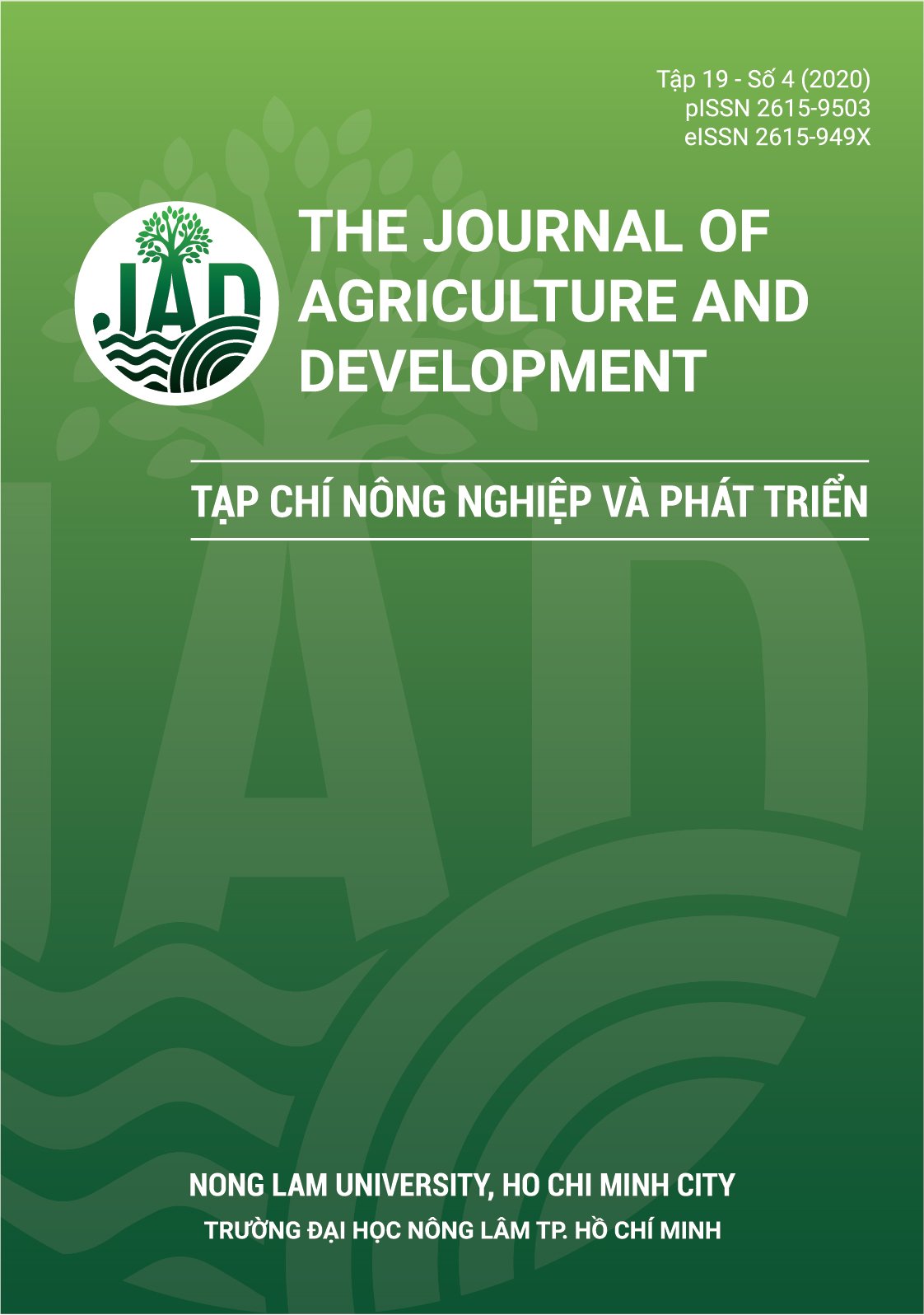Synthesis and transfer of RNAi construct for potential knock-down of gene expression of root-knot nematode (Meloidogyne graminicola) to rice (Oryza sativa L.)
Main Article Content
Abstract
Effectors play key roles in the parasitism of the plant-parasitic nematode. Silencing the effector-coding genes was applied to study the function and role of nematode effectors. In this study, the Mgra16281 gene (ID: MK322955.1) encoding an effector with the unknown function was cloned from the rice root-knot nematode Meloidogyne graminicola isolated in Long An province. To knock-down the ex-pression of this gene, an artificial microRNA was synthesized based on the Osa-MIR528 precursor and inserted into an expression vector. This microRNA can be expressed in rice to investigate the function of MGRA16281 of root-knot nematode via host-induced gene silencing approach (HIGS).
Article Details
References
Bellafiore, S., & Briggs, S. P. (2010). Nematode effectors and plant responses to infection. Current Opinion in Plant Biology 13(4), 442-448. https://doi.org/10.1016/j.pbi.2010.05.006
Bellafiore, S., Jougla, C., Chapuis, É., Besnard, G., Suong, M., Nguyen, V. P., De Waele, D., Gantet, P., & Ngo, T. X. (2015). Intraspecific variability of the facultative meiotic parthenogenetic root-knot nematode (Meloidogyne graminicola) from rice fields in Vietnam. Comptes Rendus Biologies 338(7), 471-483. https://doi.org/10.1016/j.crvi.2015.04.002
Dutta, T. K., Ganguly, A. K., & Gaur, H. S. (2012). Global status of rice root-knot nematode, Meloidogyne graminicola. African Journal of Microbiology Research 6(31), 6016-6021. https://doi.org/10.5897/AJMR12.707
Eisenback, J. D., & Triantaphyllou, H. H. (1991) Root- knot Nematodes: Meloidogyne species and races. In W. R. Nickle (Ed). Manual of agricultural nematology (191-274). New York, USA: Marcel Dekker.
Gao, L., & Liu, X. (2010). Sporulation of several biocontrol fungi as affected by carbon and nitrogen sources in a two-stage cultivation system. The Journal of Microbiology 48(6), 767-770. https://doi.org/10.1007/s12275-010-0049-2
Golden, A. M., & Birchfield, W. (1965). Meloidogyne graminicola (Heteroderidae), a new species of root-knot nematode from grass. Proceedings of the Helminthological Society of Washington 32(2), 228-231.
Goverse, A., & Smant, G. (2014). The activation and suppression of plant innate immunity by parasitic nematodes. Annual Review of Phytopathology 52, 243-265. https://doi.org/10.1146/annurev-phyto-102313-050118
Gregory, C. B., Marceline, E., & Conrad, B. (2017). The impact of plant-parasitic nematodes on agriculture and methods of control. In: Shah, M. M. (Ed.). Nematology: Concepts, diagnosis and control (121-151). London, UK: IntechOpen. https://dx.doi.org/10.5772/intechopen.68958
Hogenhout, S. A., Van der Hoorn, R. A. L., Terauchi, R., & Kamuon, S. (2009). Emerging concepts in effetor biology of plant-associated organisms. Molecular Plant Microbe Interaction 22, 115-122. https://doi.org/10.1094/MPMI-22-2-0115
Kyndt, T., Fernandez, D., & Gheyse, G. (2014). Plant-parasitic nematode infections in rice: Molecular and cellular insights. Annual Review of Phytopathology 52(1), 135-153. https://doi.org/10.1146/annurev-phyto-102313-050111
Nicol, J. M., Turner, S. J., Coyne, D. L., den Nijs, L., Hockland, S., & Maafi, Z. T. (2011). Current nematode threats to world agriculture. In: Jones, J. T., Gheysen, G., and Fenoll, C. (Eds.). Genomic and molecular genetic of plant nematode interactions (21- 43). London, UK: Springer. https://doi.org/10.1007/978-94-007-0434-3_2
Nguyen, P. V., Nguyen, L. T. N., Tran, T. B., & Ton,L. B. (2019). Construction of artificial microRNA expression vectors for inhibition of Minc16281 gene in root-knot nematode Meloidogyne incognita. The Journal of Agriculture and Development 18(4), 62-69. https://doi.org/10.52997/jad.8.04.2019
Sahoo, K. K., Tripathi, A. K., Pareek, A., Sopory, S. K., & Singla-Pareek, S. L. (2011). An improved protocol for efficient transformation and regeneration of diverse indica rice cultivars. Plant Methods 7(1), 49. https://doi.org/10.1186/1746-4811-7-49
Sambrook, J., & Russell, D.W. (2001). Molecular cloning: a laboratory manual (Vol. 2, 3rd ed.). New York, USA: Helminthological Society of Washington 32(2), 228-231.
Schwab, R., Ossowski, S., Riester, M., Warthmann, N., & Weigel, D. (2006). Highly specific gene silencing by artificial miRNAs in Arabidopsis. The Plant Cell 18(5), 1121-1133. https://doi.org/10.1105/tpc.105.039834
Somvanshi, V. S., Tathode, M., Shukla, R. N., & Rao, U. (2018). Nematode genome announcement: A draft genome for rice root-knot nematode. Meloidogyne graminicola. Journal of Nematology 50(2), 111-116. https://doi.org/10.21307/jofnem-2018-018
Trudgill, D. L., & Block, V. C. (2001). Apomictic, polyphagous root- knoot nematodes: exceptionally successful and damaging biotrophic root pathogens. Annual Review of Phytopathology 39, 53-77. https://doi.org/10.1146/annurev.phyto.39.1.53
Warthmann, N., Chen, H., Ossowski, S., Weigel, D., & Hervé, P. (2008). Highly specific gene silencing by artificial miRNAs in rice. PLoS ONE 3(3), e1829. https://doi.org/10.1371/journal.pone.0001829








